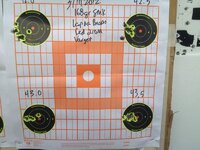- Messages
- 124
- Reactions
- 13
I'm posting this thread in hopes to get some feedback from those more experienced than I am about hand loading. I have found that my FN SPR A1A really seems to like Federal Gold Medal Match Sierra 168 gr HPBT ammo. I get consistent .5 MOA groups with this factory ammo. Well, I drank the koolaid and now I want to see what I can accomplish and learn by rolling my own rounds for the rifle.
Here is what I have DONE thus far.. I have five reloading books currently. I have read the instruction sections of each of them. I see why people suggest having more than one reference. I have read a lot of online information on loading and loading .308. I have read the stickies in this section here on the Hide.
I have put together a solid reloading bench with a good set of equipment for a beginner, **I think**.
My starting goal was to try to duplicate the factory load that my rifle seems to like. This includes putting together a safe round that fires. I did six sets of four rounds at different powder loads for my first trip to the range. They are once fired Federal brass from the above mentioned factory loads. I tumbled, cleaned primer pockets, slight chamfer/debur on the brass. My case lengths were 2.005 +/- .002.
I used Federal 210M primers, varget powder and Sierra 168gr HPBT with powder loads of 40.5, 41.0, 41.5, 41.7, 41.9 and 42.1.
I took my first ever produced twenty-four rounds to the range with my newly purchased Chrony Alpha in hopes to get an idea of velocity. Needless to say, I didn't get the Chrony setup correctly. So, my numbers were all crap. As I was leaving I got some good info on how to get better results from the Chrony.
All six of the loads were grouping four shots under .75" at 100 yards. The 42.1 stacked 3 in one hole and the fourth was adjacent to it. I was shooting off a bench with an Atlas bipod and a sandbag in the rear. I'm no expert marksman. The SPR makes me look pretty good.
So, that was my first trip out. Next trip out, I'm going to take my .17HMR to help figure out the Chrony before i shoot my .308 hand loads so I can hopefully get some data.
I was thinking of starting at 41.9 powder load and stepping up in .2 grain increments to 43.0 for the next range outing. I will also, hopefully, get a good read on the factory load that I am getting good results with.
I appreciate any input, advice, etc anyone is willing to share. This is easily one of the most fun things I have ever done.
My current goal is to work up a good load using this bullet and then shoot a few hundred of them, making small adjustments as I need/learn to see what I can do.
Here is what I have DONE thus far.. I have five reloading books currently. I have read the instruction sections of each of them. I see why people suggest having more than one reference. I have read a lot of online information on loading and loading .308. I have read the stickies in this section here on the Hide.
I have put together a solid reloading bench with a good set of equipment for a beginner, **I think**.
My starting goal was to try to duplicate the factory load that my rifle seems to like. This includes putting together a safe round that fires. I did six sets of four rounds at different powder loads for my first trip to the range. They are once fired Federal brass from the above mentioned factory loads. I tumbled, cleaned primer pockets, slight chamfer/debur on the brass. My case lengths were 2.005 +/- .002.
I used Federal 210M primers, varget powder and Sierra 168gr HPBT with powder loads of 40.5, 41.0, 41.5, 41.7, 41.9 and 42.1.
I took my first ever produced twenty-four rounds to the range with my newly purchased Chrony Alpha in hopes to get an idea of velocity. Needless to say, I didn't get the Chrony setup correctly. So, my numbers were all crap. As I was leaving I got some good info on how to get better results from the Chrony.
All six of the loads were grouping four shots under .75" at 100 yards. The 42.1 stacked 3 in one hole and the fourth was adjacent to it. I was shooting off a bench with an Atlas bipod and a sandbag in the rear. I'm no expert marksman. The SPR makes me look pretty good.
So, that was my first trip out. Next trip out, I'm going to take my .17HMR to help figure out the Chrony before i shoot my .308 hand loads so I can hopefully get some data.
I was thinking of starting at 41.9 powder load and stepping up in .2 grain increments to 43.0 for the next range outing. I will also, hopefully, get a good read on the factory load that I am getting good results with.
I appreciate any input, advice, etc anyone is willing to share. This is easily one of the most fun things I have ever done.
My current goal is to work up a good load using this bullet and then shoot a few hundred of them, making small adjustments as I need/learn to see what I can do.












